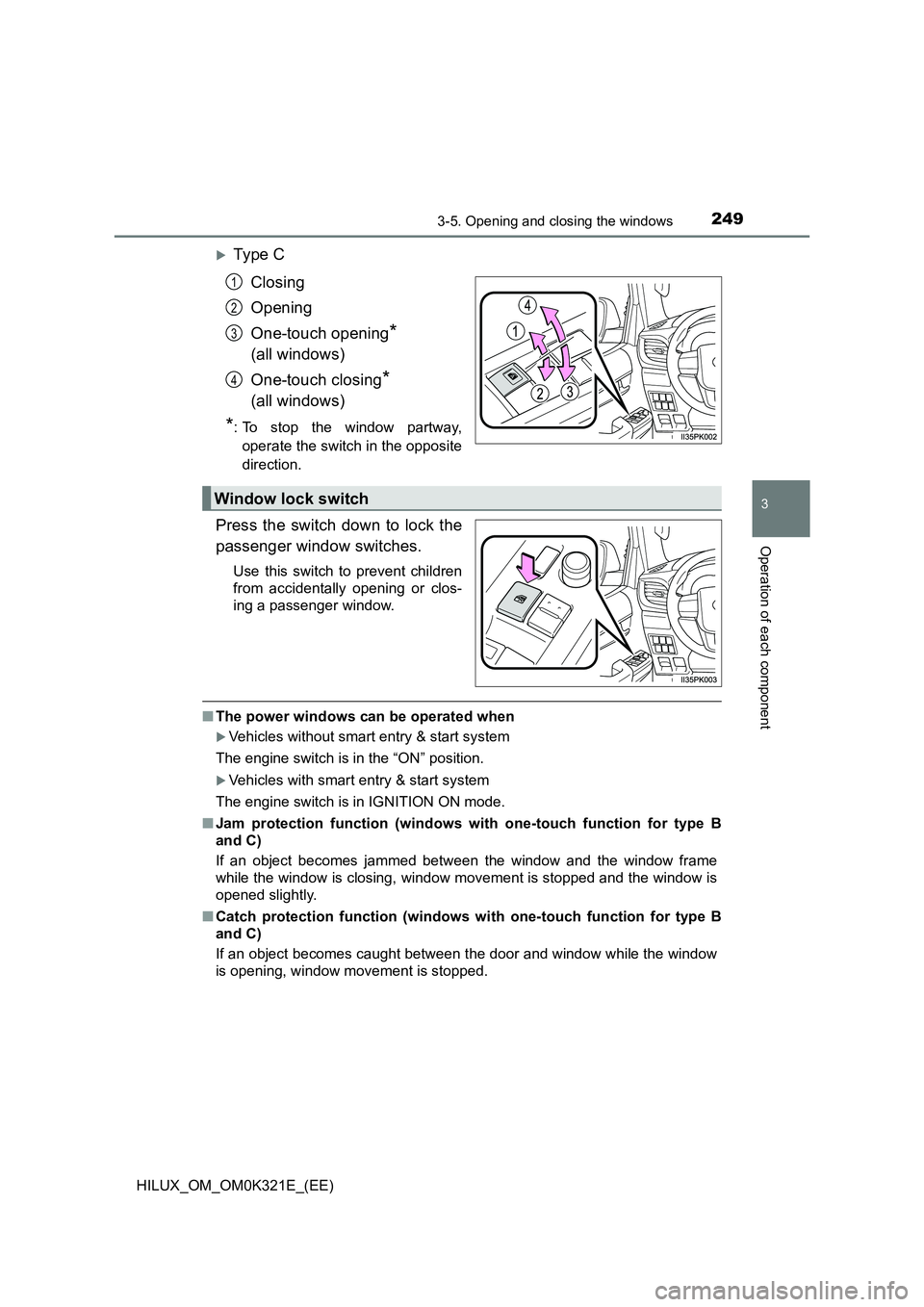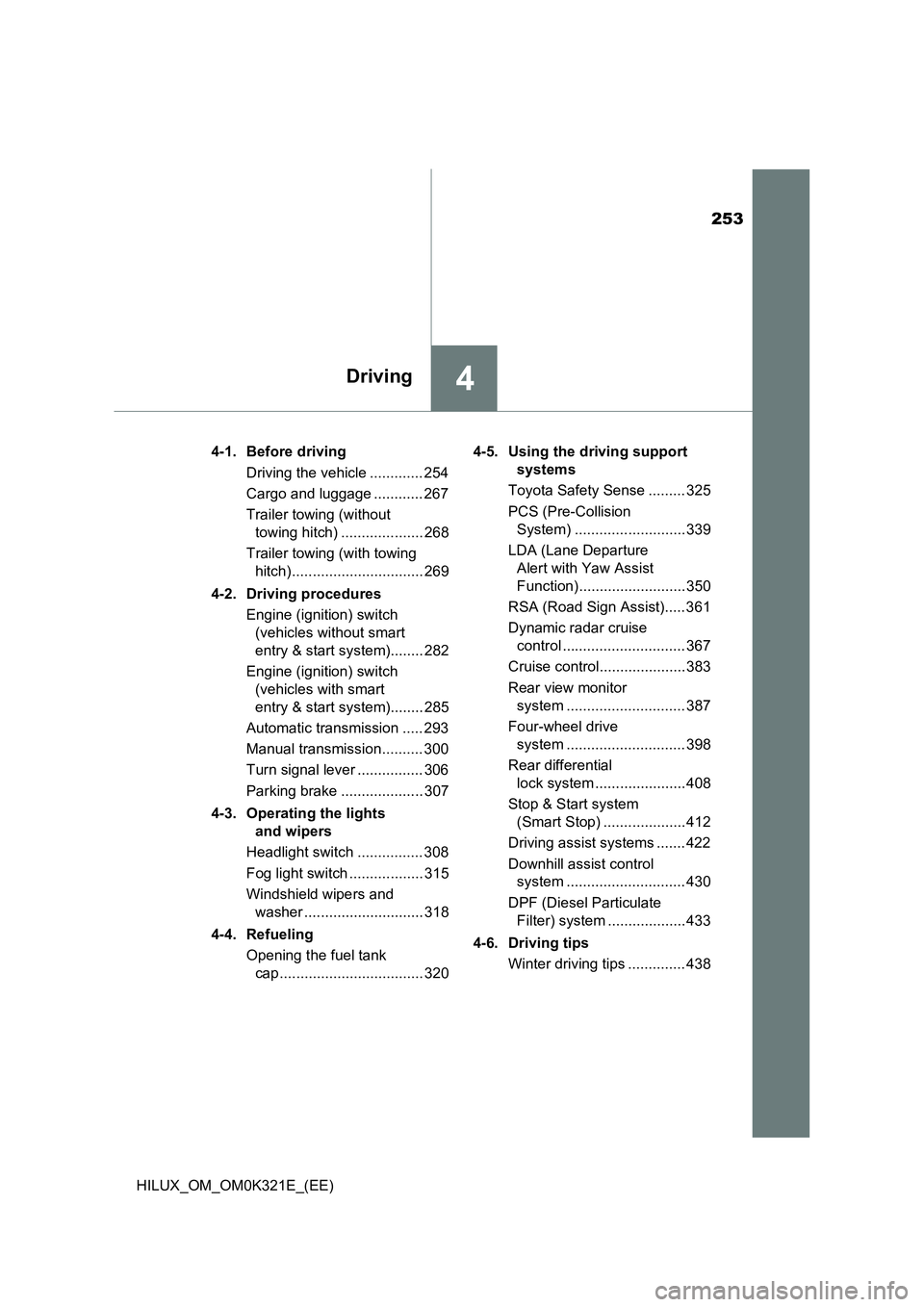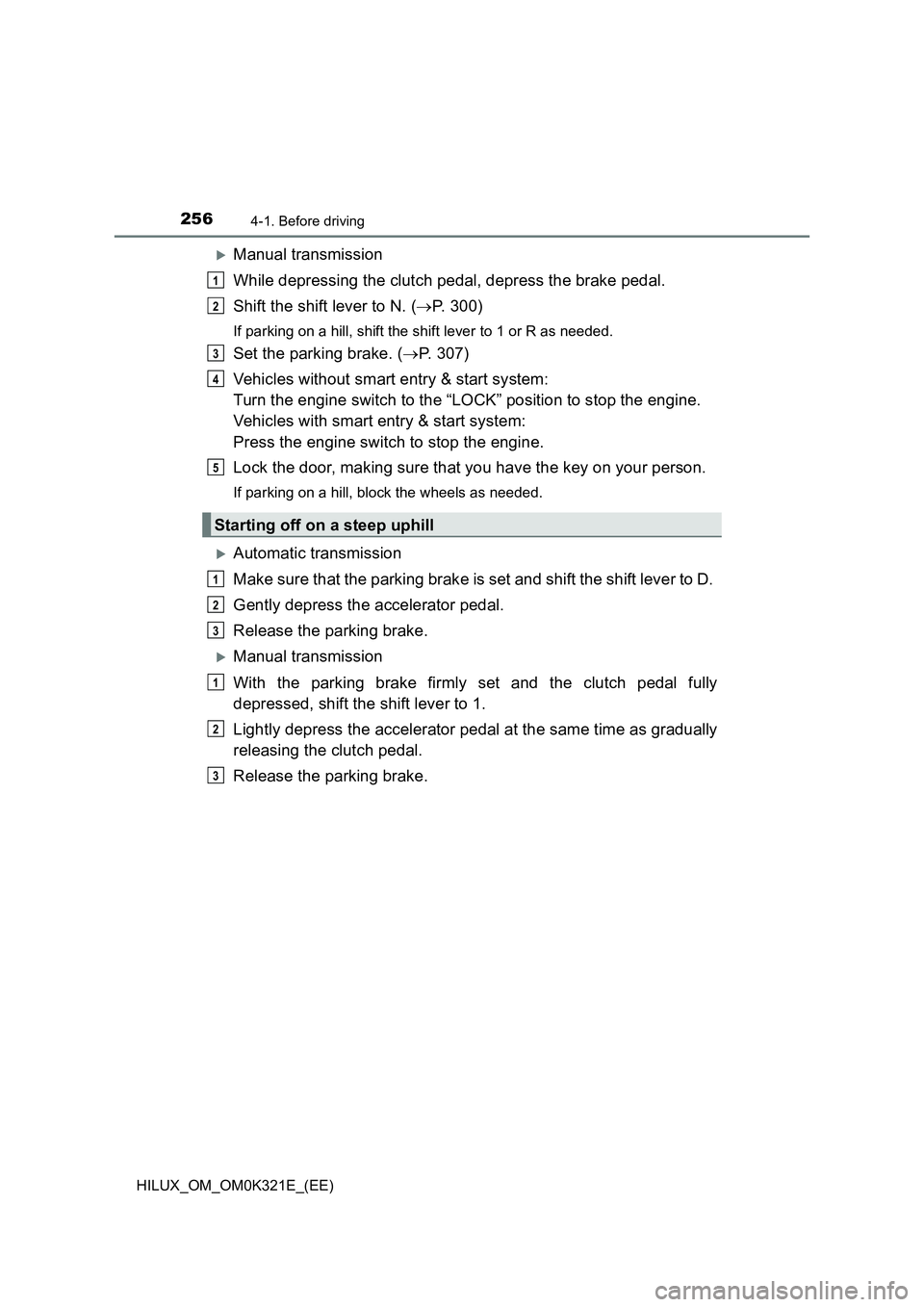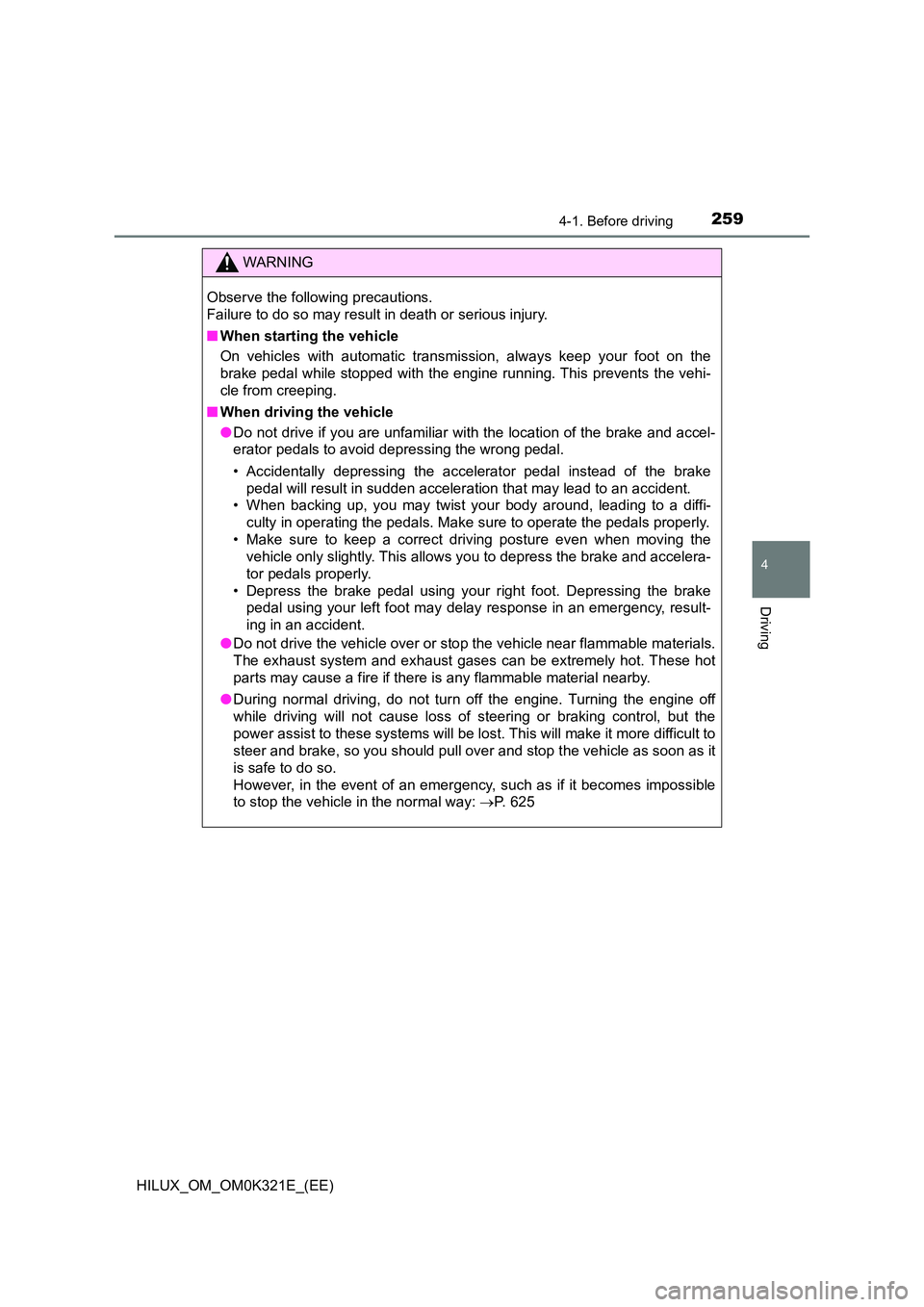Page 190 of 744
1903-2. Opening, closing and locking the doors
HILUX_OM_OM0K321E_(EE)
■ Setting the alarm (if equipped)
Locking the doors will set the alarm system. ( P. 129)
■ If a symbol indicating one or more doors are open is shown on the multi-
information display (if equipped)
One or more of the doors is not fully closed. The system also indicates which
doors are not fully closed. If the vehicle reaches a speed of 5 km/h (3 mph),
master warning light flashes and a buzzer sounds to indicate that the door(s)
are not yet fully closed.
Make sure that all the doors are closed.
◆Door lock switch (if equipped)
Locks all the doors
Unlocks all the doors
◆Inside lock button
Locks the door
Unlocks the door
The driver’s door can be opened
by pulling the inside handle
even if the lock button is in the
lock position.
Locking and unlocking the doors from inside
1
2
1
2
Page 244 of 744
2443-4. Adjusting the steering wheel and mirrors
HILUX_OM_OM0K321E_(EE)
Inside rear view mirror
The height of the rear view mirror can be adjusted to suit your driving
posture.
Adjust the height of the rear view
mirror by moving it up and down.
Reflected light from the headlights of vehicles behind can be reduced
by operating the lever.
Normal position
Anti-glare position
The rear view mirror’s position can be adjusted to enable suffi-
cient confirmation of the rear view.
Adjusting the height of rear view mirror
Anti-glare function
1
2
WARNING
Do not adjust the position of the mirror while driving.
Doing so may lead to mishandling of the vehicle and cause an accident,
resulting in death or serious injury.
Page 249 of 744

2493-5. Opening and closing the windows
3
Operation of each component
HILUX_OM_OM0K321E_(EE)
Ty pe C
Closing
Opening
One-touch opening*
(all windows)
One-touch closing*
(all windows)
*: To stop the window partway,
operate the switch in the opposite
direction.
Press the switch down to lock the
passenger window switches.
Use this switch to prevent children
from accidentally opening or clos-
ing a passenger window.
■ The power windows can be operated when
Vehicles without smart entry & start system
The engine switch is in the “ON” position.
Vehicles with smart entry & start system
The engine switch is in IGNITION ON mode.
■ Jam protection function (windows with one-touch function for type B
and C)
If an object becomes jammed between the window and the window frame
while the window is closing, window movement is stopped and the window is
opened slightly.
■ Catch protection function (windows with one-touch function for type B
and C)
If an object becomes caught between the door and window while the window
is opening, window movement is stopped.
1
2
3
4
Window lock switch
Page 253 of 744

253
4Driving
HILUX_OM_OM0K321E_(EE)
4-1. Before driving
Driving the vehicle ............. 254
Cargo and luggage ............ 267
Trailer towing (without
towing hitch) .................... 268
Trailer towing (with towing
hitch)................................ 269
4-2. Driving procedures
Engine (ignition) switch
(vehicles without smart
entry & start system)........ 282
Engine (ignition) switch
(vehicles with smart
entry & start system)........ 285
Automatic transmission ..... 293
Manual transmission.......... 300
Turn signal lever ................ 306
Parking brake .................... 307
4-3. Operating the lights
and wipers
Headlight switch ................ 308
Fog light switch .................. 315
Windshield wipers and
washer ............................. 318
4-4. Refueling
Opening the fuel tank
cap ................................... 320
4-5. Using the driving support
systems
Toyota Safety Sense ......... 325
PCS (Pre-Collision
System) ........................... 339
LDA (Lane Departure
Alert with Yaw Assist
Function).......................... 350
RSA (Road Sign Assist)..... 361
Dynamic radar cruise
control .............................. 367
Cruise control..................... 383
Rear view monitor
system ............................. 387
Four-wheel drive
system ............................. 398
Rear differential
lock system ...................... 408
Stop & Start system
(Smart Stop) .................... 412
Driving assist systems ....... 422
Downhill assist control
system ............................. 430
DPF (Diesel Particulate
Filter) system ................... 433
4-6. Driving tips
Winter driving tips .............. 438
Page 256 of 744

2564-1. Before driving
HILUX_OM_OM0K321E_(EE)
Manual transmission
While depressing the clutch pedal, depress the brake pedal.
Shift the shift lever to N. ( P. 300)
If parking on a hill, shift the shift lever to 1 or R as needed.
Set the parking brake. (P. 307)
Vehicles without smart entry & start system:
Turn the engine switch to the “LOCK” position to stop the engine.
Vehicles with smart entry & start system:
Press the engine switch to stop the engine.
Lock the door, making sure that you have the key on your person.
If parking on a hill, block the wheels as needed.
Automatic transmission
Make sure that the parking brake is set and shift the shift lever to D.
Gently depress the accelerator pedal.
Release the parking brake.
Manual transmission
With the parking brake firmly set and the clutch pedal fully
depressed, shift the shift lever to 1.
Lightly depress the accelerator pedal at the same time as gradually
releasing the clutch pedal.
Release the parking brake.
Starting off on a steep uphill
1
2
3
4
5
1
2
3
1
2
3
Page 257 of 744

2574-1. Before driving
4
Driving
HILUX_OM_OM0K321E_(EE)
■When starting off on an uphill (vehicles with hill-start assist control sys-
tem)
The hill-start assist control will activate. ( P. 422)
■ Driving in the rain
● Drive carefully when it is raining, because visibility will be reduced, the win-
dows may become fogged-up, and the road will be slippery.
● Drive carefully when it starts to rain, because the road surface will be espe-
cially slippery.
● Refrain from high speeds when driving on an expressway in the rain,
because there may be a layer of water between the tires and the road sur-
face, preventing the steering and brakes from operating properly.
■ Engine speed while driving (automatic transmission)
In the following conditions, the engine speed may become high while driving.
This is due to automatic up-shifting c ontrol or down-shifting implementation to
meet driving conditions. It does not indicate sudden acceleration.
● The vehicle is judged to be driving uphill or downhill
● When the accelerator pedal is released
■ Restraining the engine output (Brake Override System)
● When the accelerator and brake pedals are depressed at the same time, the
engine output may be restrained.
● Vehicles without multi-information display: A warning light comes on while
the system is operating. ( P. 637)
● Vehicles with multi-information display: A warning message is displayed on
the multi-information display while the system is operating. ( P. 645)
■ Breaking in your new Toyota
To extend the life of the vehicle, observing the following precautions is recom-
mended:
● For the first 300 km (200 miles):
Avoid sudden stops.
● For the first 800 km (500 miles) (models for model code destination W*):
Do not tow a trailer. ( P. 269)
*: See “Checking your vehicle’s model” if you are not sure of which model
your vehicle is. ( P. 1 2 )
● For the first 1000 km (600 miles):
• Do not drive at extremely high speeds.
• Avoid sudden acceleration.
• Do not drive continuously in the low gears.
• Do not drive at a constant speed for extended periods.
• Do not drive slowly with the manual transmission in a high gear.
Page 259 of 744

2594-1. Before driving
4
Driving
HILUX_OM_OM0K321E_(EE)
WARNING
Observe the following precautions.
Failure to do so may result in death or serious injury.
■ When starting the vehicle
On vehicles with automatic transmission, always keep your foot on the
brake pedal while stopped with the engine running. This prevents the vehi-
cle from creeping.
■ When driving the vehicle
● Do not drive if you are unfamiliar with the location of the brake and accel-
erator pedals to avoid depressing the wrong pedal.
• Accidentally depressing the accelerator pedal instead of the brake
pedal will result in sudden acceleration that may lead to an accident.
• When backing up, you may twist your body around, leading to a diffi-
culty in operating the pedals. Make sure to operate the pedals properly.
• Make sure to keep a correct driving posture even when moving the
vehicle only slightly. This allows you to depress the brake and accelera-
tor pedals properly.
• Depress the brake pedal using your right foot. Depressing the brake
pedal using your left foot may delay response in an emergency, result-
ing in an accident.
● Do not drive the vehicle over or stop the vehicle near flammable materials.
The exhaust system and exhaust gases can be extremely hot. These hot
parts may cause a fire if there is any flammable material nearby.
● During normal driving, do not turn off the engine. Turning the engine off
while driving will not cause loss of steering or braking control, but the
power assist to these systems will be lost. This will make it more difficult to
steer and brake, so you should pull over and stop the vehicle as soon as it
is safe to do so.
However, in the event of an emergency, such as if it becomes impossible
to stop the vehicle in the normal way: P. 625
Page 260 of 744

2604-1. Before driving
HILUX_OM_OM0K321E_(EE)
WARNING
Observe the following precautions.
Failure to do so may result in death or serious injury.
■ When driving the vehicle
● Use engine braking (downshift) to maintain a safe speed when driving
down a steep hill.
Using the brakes continuously may cause the brakes to overheat and lose
effectiveness. ( P. 2 9 4 )
● Do not adjust the positions of the steering wheel, the seat, or the inside or
outside rear view mirrors while driving.
Doing so may result in a loss of vehicle control.
● Always check that all passengers’ arms, heads or other parts of their body
are not outside the vehicle.
● On vehicles with manual transmission, observe the following to prevent
the clutch from being damaged.
• Do not operate the clutch halfway for a long period of time unless it is
necessary.
• Do not operate the clutch half or partial engaged to control the vehicle
speed, such as to drive the vehicle at a low speed, to hold the vehicle
on a slope, etc.
• Do not depress the brake pedal during operating the clutch half or par-
tial engaged.
Doing so could not only speed up the clutch wear, but also damage the
clutch or even cause a fatal accident such as vehicle fire.
■ When driving on slippery road surfaces
● Sudden braking, acceleration and steering may cause tire slippage and
reduce your ability to control the vehicle.
● Sudden acceleration, engine braking due to shifting, or changes in engine
speed could cause the vehicle to skid.
● After driving through a puddle, lightly depress the brake pedal to make
sure that the brakes are functioning properly. Wet brake pads may prevent
the brakes from functioning properly. If the brakes on only one side are wet
and not functioning properly, steering control may be affected.